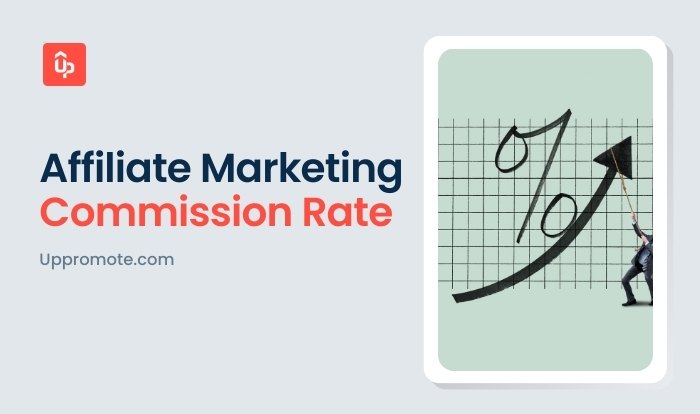The backbone of affiliate marketing lies in the commission you pay your partners. It helps you attract new affiliates to sell your products. It’s also an incentive to keep your existing affiliates motivated.
As you run an affiliate campaign, you will reward your publishers with a specific commission for each sale they make via their affiliate links.
But do you know the standard affiliate commission in your niche? What is a good commission rate for affiliates? How much should you pay your affiliates? Simply put, you need to set a rate appealing to top talents while balancing your profit margin.
In this article, we’ll provide a comprehensive guide on setting affiliate commission rates for your program.
Let’s get started!
TL;DR
- Creating attractive commission rates helps you attract top affiliates. It also keeps your current partners motivated.
- The ideal commission rates should make you competitive in your niche without eating into your profits.
- 7 key points you should keep in mind when deciding on affiliate marketing commission rates:
-
- Get to know different types of commission rates
- Measure customer lifetime value (CLV)
- Research your niche and competitor’s commission rates
- Plan your starting commission on the lower side
- Determine whether you’ll offer commission bonuses
- Identify commission conditions for your affiliates
- Check regularly and tailor your commission rates
- It’s important to find the right affiliate software to use. The software will give you full control over affiliate commissions.
- Want to set commission rates for each affiliate program quickly? Use UpPromote, the #1 Shopify affiliate software, trusted by experts, 115,000+ global customers to see how you can start with no prior experience.
Unlock UpPromote’s robust settings & create dynamic commission structures to outsmart your competitors.
7 Key Considerations For Setting Affiliate Marketing Commission Rates
Determining commission rates can be challenging, especially for newcomers to affiliate marketing. You need to balance attractive rates to incentivize affiliates with affordable payments.
Don’t worry, though. Keep reading to figure out the suitable commission rate for your affiliate campaign.
Understand different types of commission rates
Affiliate commission rates refer to the percentage of a sale or a fixed amount of money you pay partners to promote your products and drive a conversion, such as a sale, a lead, or another predefined action.
Different affiliate marketing programs apply different commission types and structures. Have no idea which model to begin with? Consider a few common ones below:
| Type of commission rate | Definition | Some niche apply | Example |
| Percent-based commission | Pay affiliates a percentage of the sale amount. | Travel Fashion ElectronicsBeautyEducation |
Agoda offers affiliates a 4% commission on completed bookings. For a $200 booking, the affiliate earns $8. |
| Flat rate commission | Pay partners a fixed dollar amount for each sale or item. | Fitness
Food Financial Digital products |
Personal Capital offers affiliates a $144 commission per sign-up. |
| Tiered commission | Offer increasing commission rates based on affiliate performance, either as a percentage or a fixed amount. | Software
Digital marketing services Business coaching |
A2 Hosting offers commissions to affiliates:
|
| Lifetime commission | Pay affiliates commissions on the initial sale and any future purchases made by the referred customer. | SaaS
Web builder |
Ecwid offers 20% lifetime commissions. If a customer subscribes to a $45/month plan, the affiliate earns $9 per month as long as the customer remains subscribed. |
You want to set distinct types of commission rates for each affiliate program? It’s perfectly fine. Using affiliate commission tracking software is a great way to help.
UpPromote helps you set multiple affiliate programs with dynamic commission structures. You can create different commission rules to align with the specific goals of each affiliate campaign.
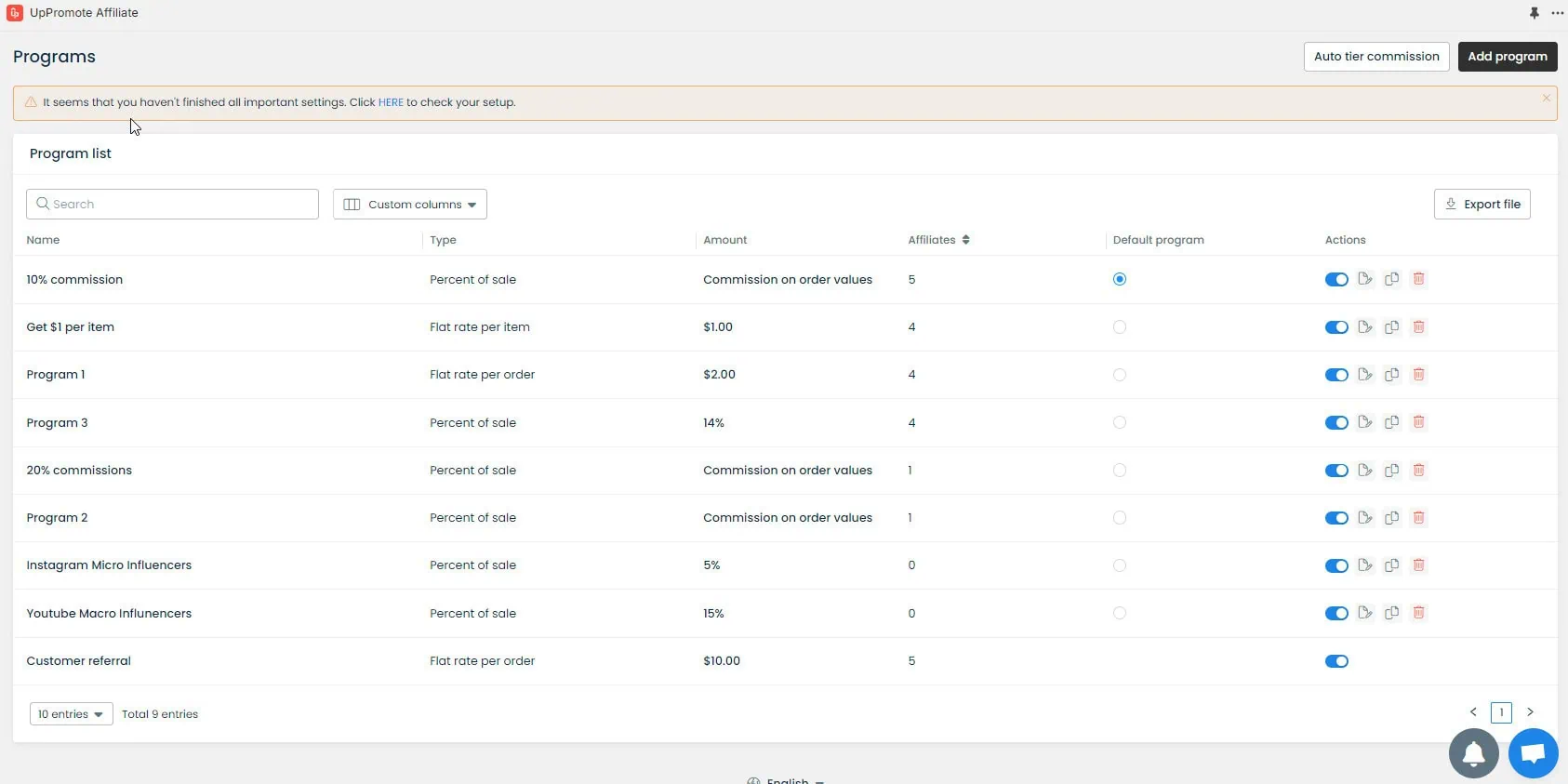
Calculate customer lifetime value (CLV)
Your profit margins determine how much you can afford to pay your affiliates. However, this metric tends to fluctuate and is hard to determine. To simplify things, use the average customer lifetime value (CLV).
Customer lifetime value (CLV) calculates the total net profit a company expects to make from a customer throughout their ongoing relationship. It accounts for the customer’s initial purchase, ongoing purchases, and the average time the customer stays with the company.
Understanding your CLV helps you decide on an affordable and sustainable affiliate marketing commission rate.
To accurately evaluate CLV, consider the following steps:
- Determine the average purchase value: Find the average amount spent per purchase by dividing total revenue by the number of orders.
- Estimate purchase frequency: Assess how often a typical customer makes a purchase within a specific period.
- Calculate customer lifespan: Estimate the average duration a customer continues to make purchases from your business. This can be based on historical data.
- Compute CLV: Multiply the average purchase value, purchase frequency, and customer lifespan. The formula is:
| CLV = Average purchase value × Average frequency rate × average customer |
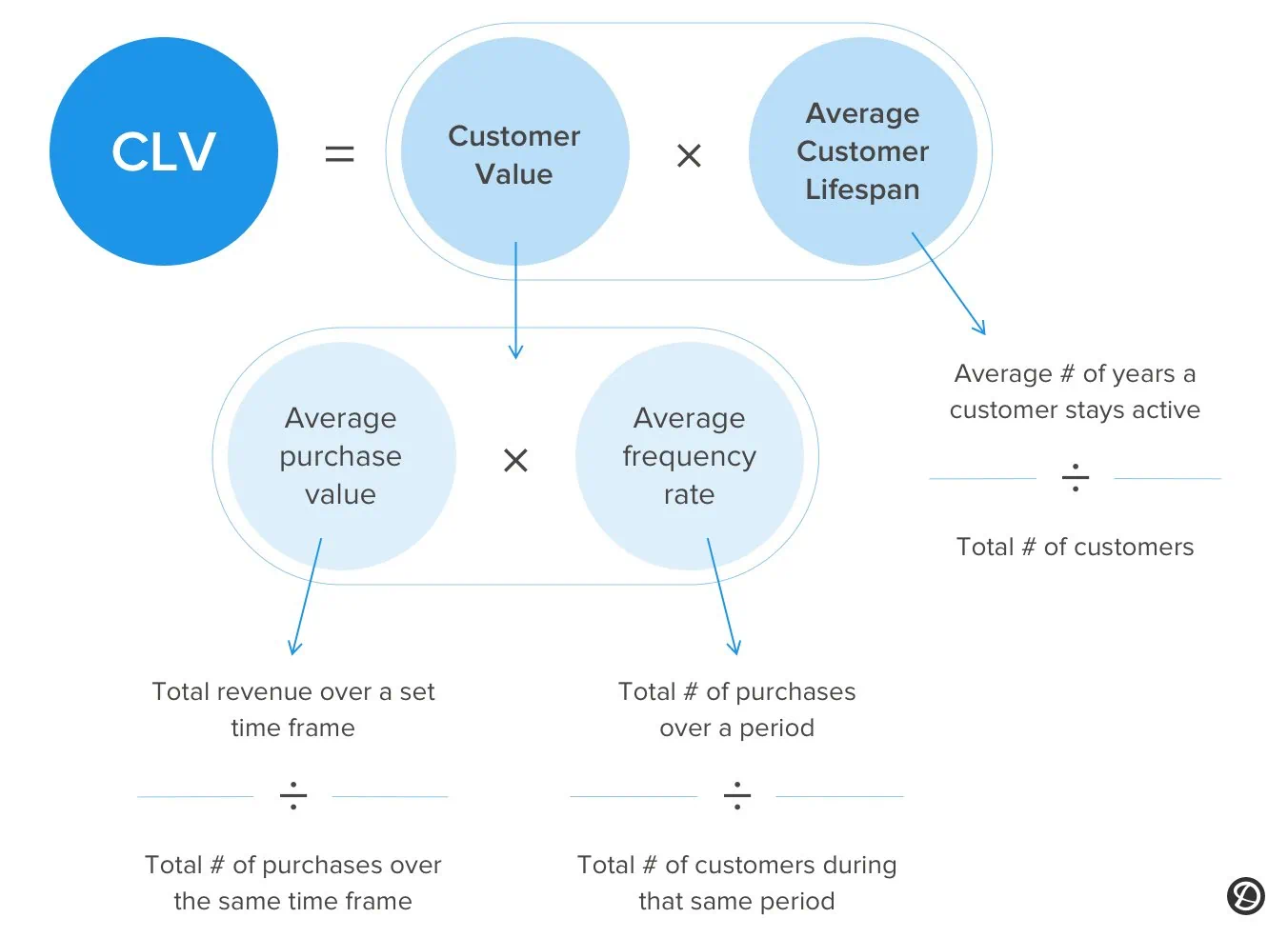
To calculate your average CLV, you need to answer the following questions:
- Average purchase value: How much does it often cost to bring in a new buyer?
- Average frequency rate: What percentage of customers do you get in a given year?
- Average customer lifespan: How much revenue can each of your customers bring in?
Take a look at this example:
- Annual profit from the customer: $1,500
- Number of years they are your customer: 3 years
- Cost to acquire that customer: $1,800
The average CLV for this customer would be:
| Average CLV = (Average annual profit×Average customer lifespan)−Customer acquisition cost
Average CLV = (1,500×3)−1,800=2,700 |
This means each customer generates $2,700 in profit over their lifetime after accounting for the cost to acquire them.
Evaluating CLV helps you understand the long-term value of customers acquired through affiliates and allows you to set commission rates that are both competitive and profitable.
Evaluate your industry and competitor’s commission rates
Discover competitors’ commission rates
Evaluating your competitors’ commission rates is a critical step in setting your own. By understanding what others in your industry are offering, you can ensure your rates are competitive enough to attract and retain top-performing affiliates. If your rates are too low, affiliates may go elsewhere. In contrast, if they’re too high, they will eat in your pocket.
Here’re some ways to keep in mind for researching competitor affiliate program commission rates:
- Visit competitor websites: Check your competitors’ affiliate program pages to see their commission structures, payout schedules, and any performance-based incentives they offer.
- Use industry reports: Look for reports that show standard commission rates in your industry. Websites like AffStat, AM Navigator, or CJ Affiliate often publish annual reports on affiliate marketing trends and rates.
- Join affiliate forums: Engage with affiliate marketing communities and forums on Facebook, LinkedIn, or Quora. Participate in discussions or search through threads to gather information about typical commission rates in your field.
- Discover affiliate networks or affiliate marketplace: Explore popular networks or marketplaces like ShareASale, Commission Junction, Rakuten Marketing, UpPromote’s Marketplace, etc. Browse through the listings of similar products and services to see the commission rates offered by other businesses in your niche.
For example, if you’re a beauty store owner, you can join UpPromote’s Marketplace and filter the category according to your niche to explore offers from other merchants:
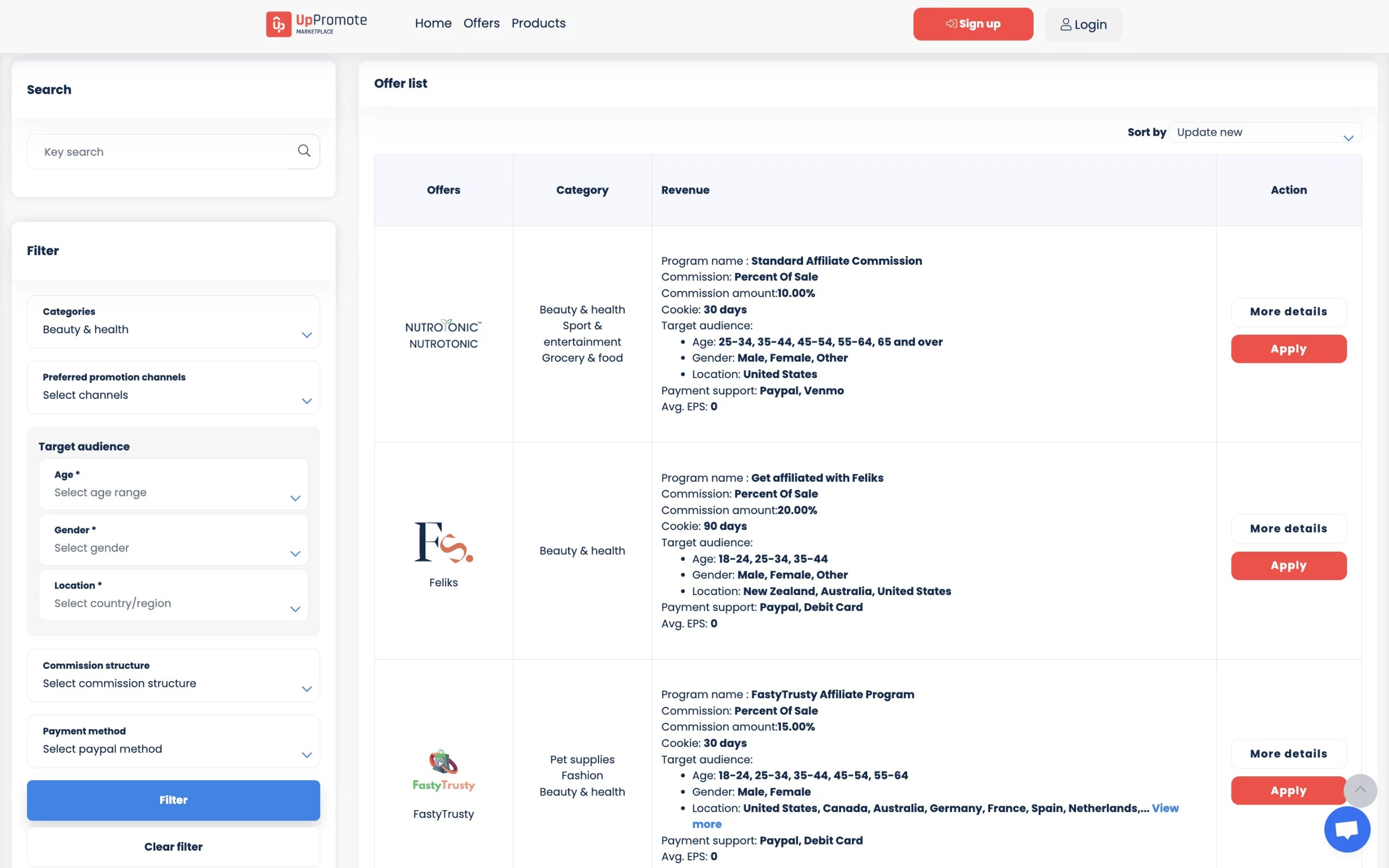
And don’t forget to consider these factors when examining their commission structure:
- Which action triggers the affiliate payouts: a generated lead, a sale, a click, etc.?
- What commission structure does the competitor follow: flat rate, percentage, or tiered commission?
- Are affiliates paid in credit toward the brand’s products or in cash?
- Do top-performing individuals receive bonuses or higher commissions for affiliates?
- How does their commission rate stack up? Does it seem low, high, or reasonable compared to their product prices and other competitors’ programs?
After analyzing the commission rates offered in competitors’ affiliate programs, you can set a competitive, attractive rate of your own. It is difficult to recommend whether the rate should be high or low. This largely depends on your product prices and the number you expect to sell within a given period.
Undoubtedly, a 30% commission on a $150 item is less valuable than an 8% commission on a $1,700 item. Affiliates are okay with low commissions from high-value merchants since they can earn much more from a few sales, while business owners selling low-priced and mid-range goods should offer a higher rate.
Your commission rate should be competitive compared to other businesses that aim to attract the same affiliates. Simply put, if most competitor affiliate programs provide a 15% average affiliate commission rate, you will not succeed when offering only 10%.
Turn on UpPromote’s powerful settings to craft a lucrative commission rate that affiliates can’t resist!
Explore your industry benchmarks
Knowing standard commission rates in your niche will help you position your program more appropriately.
You can use some of the same methods mentioned above to gather information about competitors’ commission rates, such as utilizing industry reports or joining affiliate forums, to figure out what a typical affiliate commission is in your niche.
What is the average affiliate marketing percentage? Take some references:
- Retail and eCommerce: Typically range from 5% to 15%.
- Digital products and software: Often range from 20% to 50% due to higher margins.
- Travel and hospitality: These usually range from 4% to 10%, but they can go higher for luxury services.
- Financial services: Commissions might be per lead rather than per sale, often ranging from $50 to $200 per lead.
Based on your research, set a commission rate that is competitive but still allows you to make a profit. If the average commission for affiliate programs in your industry is between 5% and 20%, and your competitors offer 10%, you might start there but add bonuses or special promotions to stand out.
Set your starting affiliate commission on the lower side
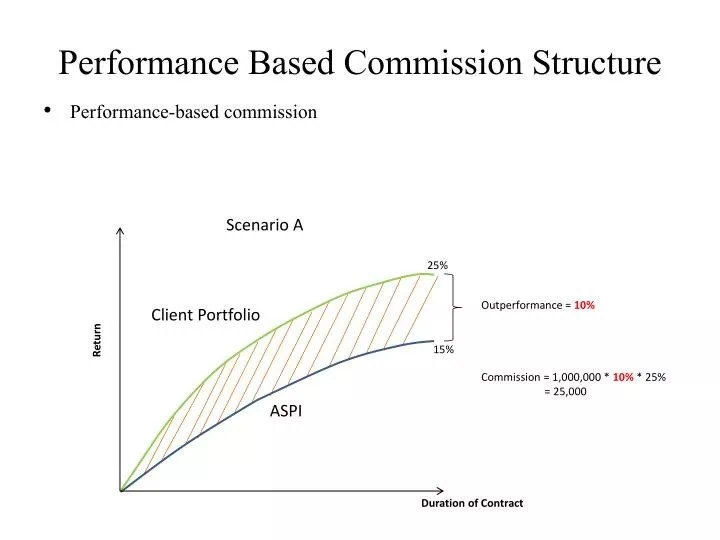
Now that you have analyzed your CLV and other brands’ affiliate programs, it is time to set your own rate. Pinpoint a range of commissions that is both competitive and affordable. Then, choose a base rate at the lower end of that range.
Why? Starting with a lower commission rate allows you to manage your costs effectively while evaluating your affiliate program’s performance and impact. It provides a cushion to adjust rates based on real data and feedback without overspending from the beginning.
You can experiment with bonuses and higher tiers for excellent affiliates. You can also set up promotions for your affiliates’ website visitors because a low rate results in more profits for your business.
Even better, you can still give traditional sales and discounts to certain customers. Or try out other types of marketing (e.g., a referral program) without overspending.
You can raise the commission rate later while prioritizing your business needs first. Increasing the commission will not bother affiliates as it adds to their earnings. But starting with a rate you are later forced to drop is a risk you do not want to take. Existing affiliates may walk away, and it is more challenging to recruit new ones.
If you want to switch to higher commissions, keep in mind some tips for gradual rate increases:
- Monitor your affiliate performance: Are your partners showing consistent results and increasing sales? If so, consider gradually increasing their commission rates.
- Reward top performers: Use higher commission rates as an incentive to motivate top-performing affiliates.
- Seasonal adjustments: Is it peak season or a special promotion? Implement higher commission rates to boost affiliate activity.
For instance, you start your program with an affiliate marketing commission percentage of 5% using UpPromote like this:
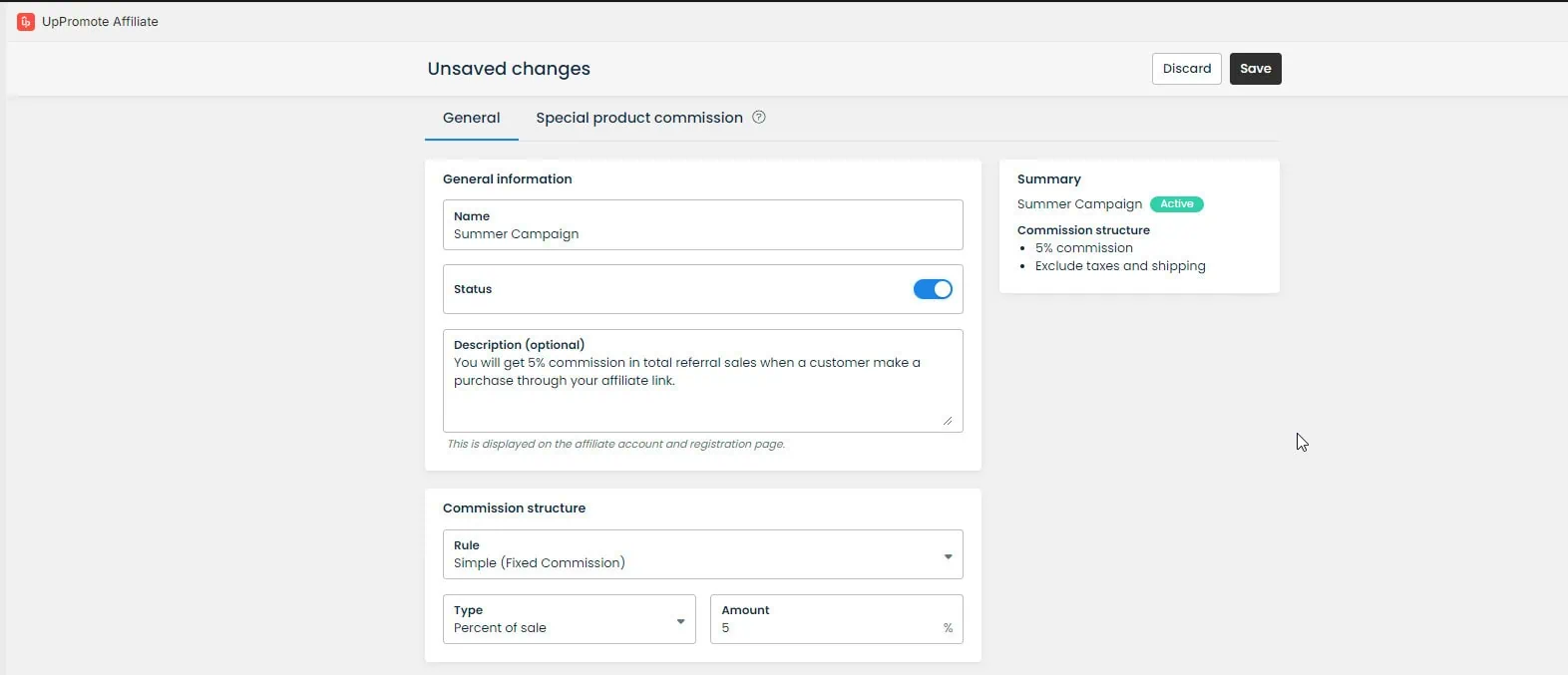
Over the first six months, you monitor your affiliates’ performance and notice that the top 10% of your affiliates are driving significant sales. You could then increase their commission rate to 7% as a reward for their performance while keeping the starting rate for new affiliates at 5%.
To make things smoother, you can make use of our Auto-tier commission setting. Affiliates will automatically move to a higher-commission program based on their performance and your preset conditions.
Activate UpPromote’s flexible setups to craft a smart commission structure in your niche.
Consider performance-based bonuses
Besides the general affiliate marketing commission rates, offering bonuses for top-performing affiliates is a good idea to make the program interesting. It’s also a great way to keep your partners engaged and motivated to strive for better outcomes, acquiring more sales to increase your revenue.
See if you can apply performance-based bonuses in these ways:
| Types of performance-based bonuses | Explain | Examples |
| Sales volume bonus | Provide bonuses for affiliates who exceed certain sales thresholds within a specified period | An affiliate who achieves 50 sales in a month receives an additional 5% bonus on all sales made that month. |
| Tiered commission structures | Implement a tiered commission system where commission rates increase as affiliates hit higher sales milestones. | An affiliate earns 5% on the first 20 sales, 7% on the next 30 sales, and 10% on any sales beyond 50. |
| New customer acquisition bonus | Offer bonuses for bringing in new customers | An affiliate receives a $10 bonus for every new customer referred. |
| Seasonal or promotional bonus | Introduce limited-time bonuses during peak seasons or special promotional periods to encourage increased affiliate activity. | During the holiday season, affiliates earn an extra 2% commission on all sales. |
| Streak bonus | Reward affiliates for maintaining consistent performance over consecutive periods. | An affiliate who makes at least 10 sales every week for a month receives a $100 streak bonus. |
| Recurring commission bonus | Offer an extra commission for an affiliate as a customer who originally bought via his/her affiliate link upgrades or renews their product. | An affiliate receives a 20% commission on the initial sale and a 5% recurring commission for every renewal or subscription payment made by the referred customer. |
If you use UpPromote, you can set up bonus rules with ease to motivate your affiliates. Our affiliate management software lets you create various types of rewards to meet your marketing campaign needs.
Within our app, go to Motivation > Bonuses > Set up > Click on the Create bonus button.
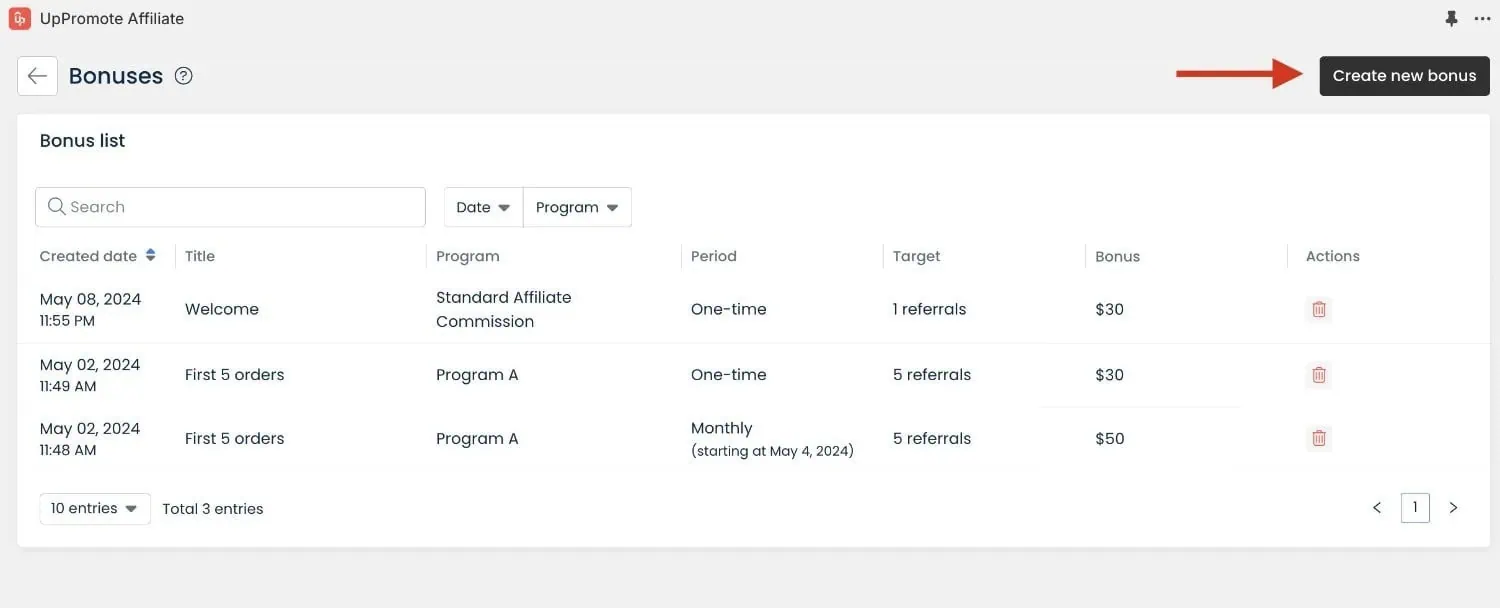
When you’re on the Create new bonus page > Go through each field and fill out its information to create your desired Bonus rule.

Incorporating performance-based bonuses into your affiliate program can drive better results and foster a more motivated and loyal affiliate network. By rewarding affiliates for high performance, you create a win-win situation where both your business and your affiliates can thrive.
When implementing performance-based bonuses, let’s pay attention to:
- Define specific, measurable targets that affiliates need to achieve to earn bonuses. Ensure these goals are challenging yet attainable.
- Clearly outline the bonus program details to your affiliates. Provide examples and answer any questions to ensure they understand the criteria.
Define clear commission conditions
Why should you set apparent commission conditions and requirements for affiliates to get the rewards? It will ensure transparency and avoid misunderstandings between you and your affiliates.
Clear terms help build trust, set expectations, and maintain a healthy relationship with your partners. Here’s what to think about:
Affiliate requirements to earn a commission
Specify the actions affiliates must take to earn commissions. Most businesses pay a commission for each sale made via an affiliate link.
Some even state that affiliates can only earn this money if the customer does not return the product or cancel the service within a time period.
This is a low-risk guarantee for your business. You only pay for affiliates when your business receives a return on investment.
Commission rates and payment terms
Clearly outline the different commission rates and any tiered structures.
You can take BarkBox as an example in showcasing their commission rates:
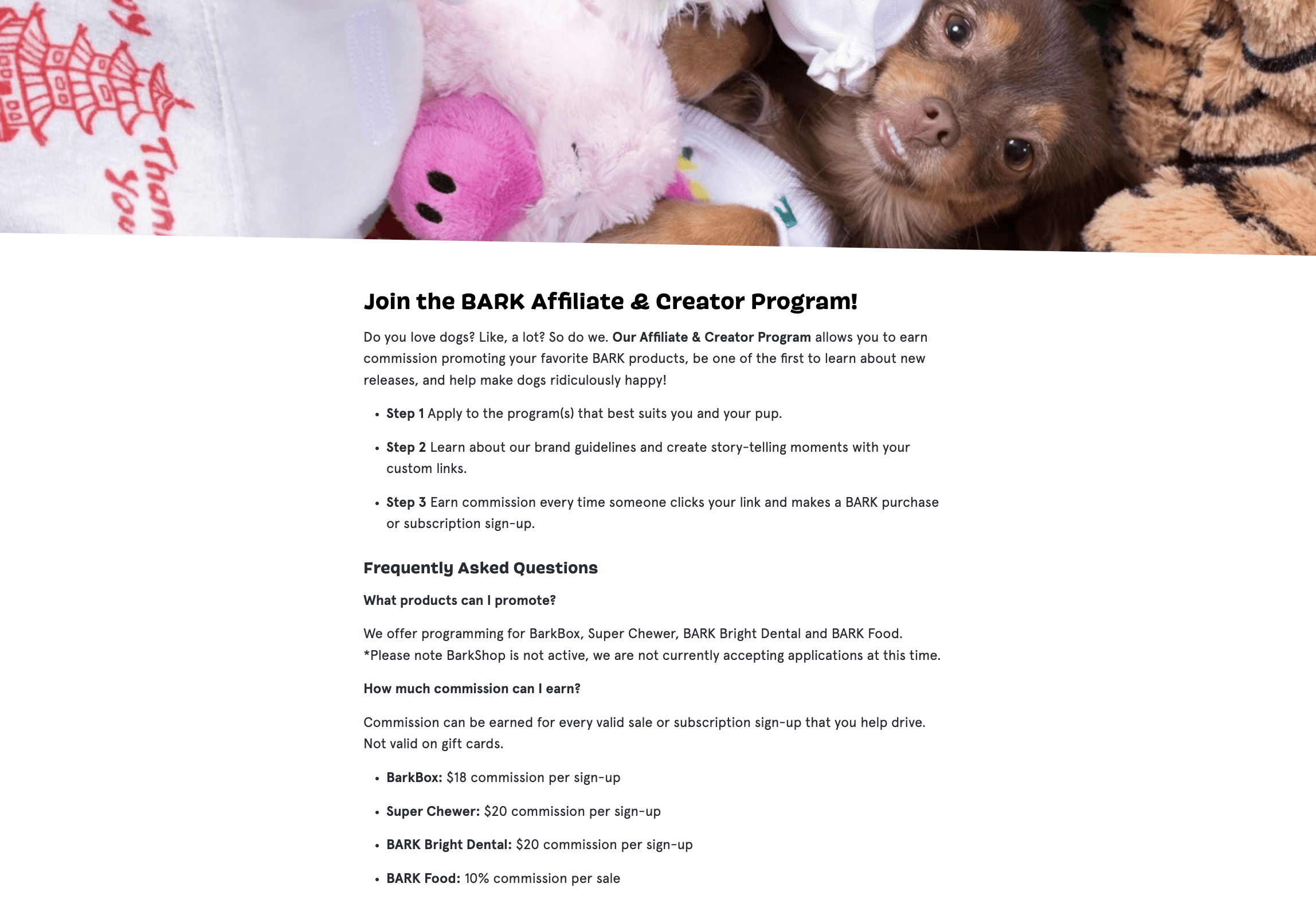
And define when and how commissions will be paid out (if possible). Include information about payment frequency (e.g., monthly, weekly) and the payment methods available (e.g., PayPal, bank transfer).
Cookie duration
How long will your affiliates qualify for a commission after someone visits their links? Are they commissioned only when that visitor purchases right away? Or can they still earn that reward after a certain time period?
The affiliate cookie is something you need to include in your affiliate marketing agreement with a potential partner. Using affiliate tracking cookies within a given time allows you to commission an affiliate days to months after the lead clicks your affiliate links and makes a purchase later.
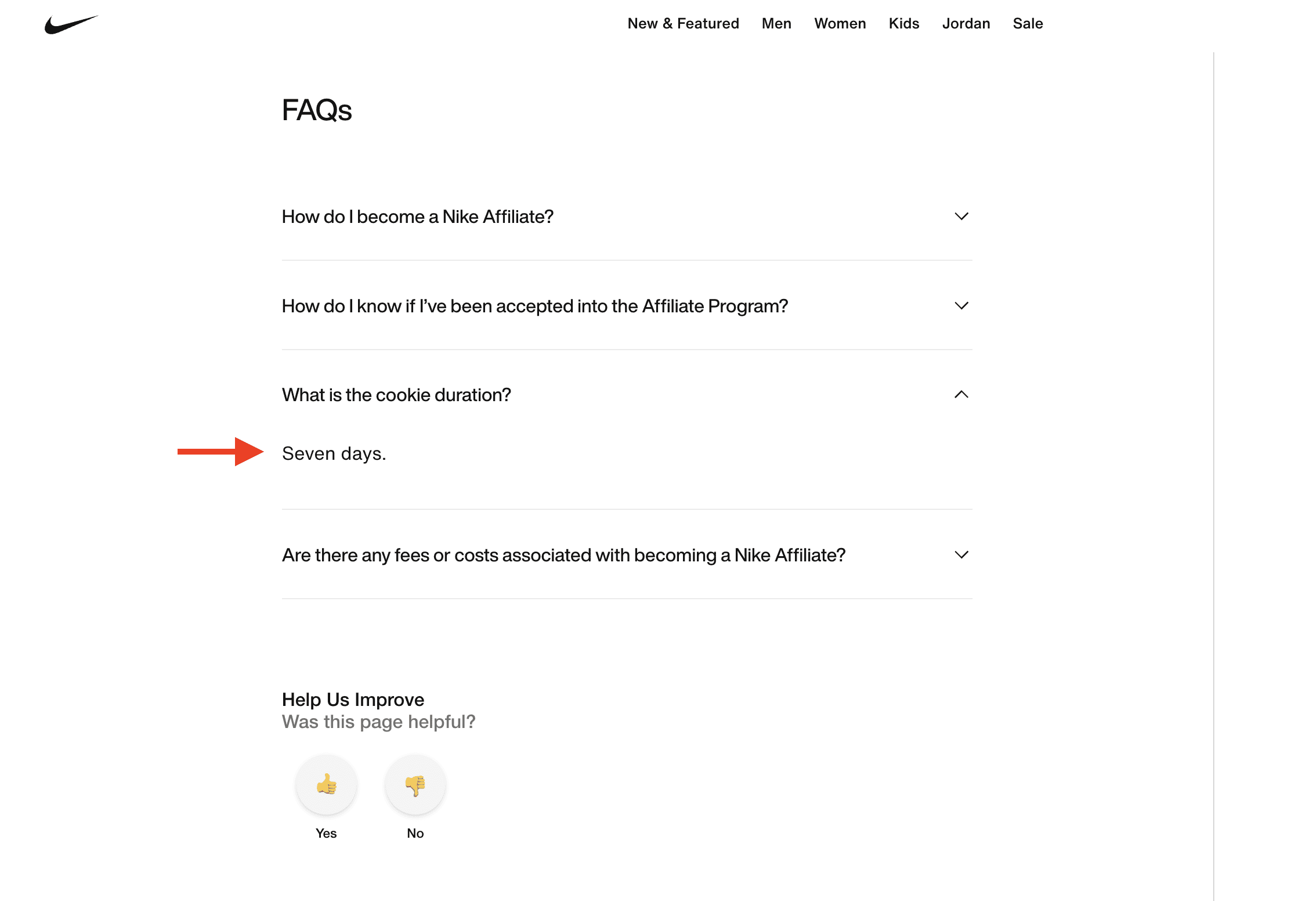
For instance, an affiliate joins Nike’s affiliate program. Then, a customer visited his or her affiliate link but did not buy anything at that moment. If they return after 7 days and make a purchase, it still counts as a completed sale for Nike’s affiliate.
Determine how long you want these affiliate cookies to last, depending on your choice. Some programs make it last for days, months, or even longer.
Besides the affiliate marketing commission rate, your cookie settings should also be competitive with competitor programs in your niche. A reliable affiliate program software will help you set up cookies within your chosen time frame.
If you use UpPromote, you can set the cookie period for each program. Within our dashboard, go to Settings > General > Brand settings > Cookie settings.
For example, you set the cookie duration to 30 days. During these 30 days, if the customer buys anything from your shop, the commission will be credited to the affiliate. From day 31 onward, any purchases by the customer not through the affiliate link will not give the affiliate any commission.
Return and refund policy
What happens if a referred customer sends back your products? Do you still pay commissions to affiliates for these sales? If not, how do returns and refunds affect commissions?
Inform your affiliates clearly about how commissions are deducted for returned or refunded sales. For example, if you specify a sale is refunded within 30 days, the commission will be subtracted from the affiliate’s next payment.
Compliance and ethical guidelines
Affiliates must follow all rules and act ethically to stay in the program. This means obeying laws and all relevant regulations, like protecting data and privacy.
They should use only approved marketing materials and avoid misleading practices. Affiliates must not engage in spam, fraud, or activities that could harm the brand’s reputation.
Breaking these rules can lead to being removed from the program and losing earned commissions.
You can see the way TréSkin clarifies regulations regarding joining their affiliate programs:
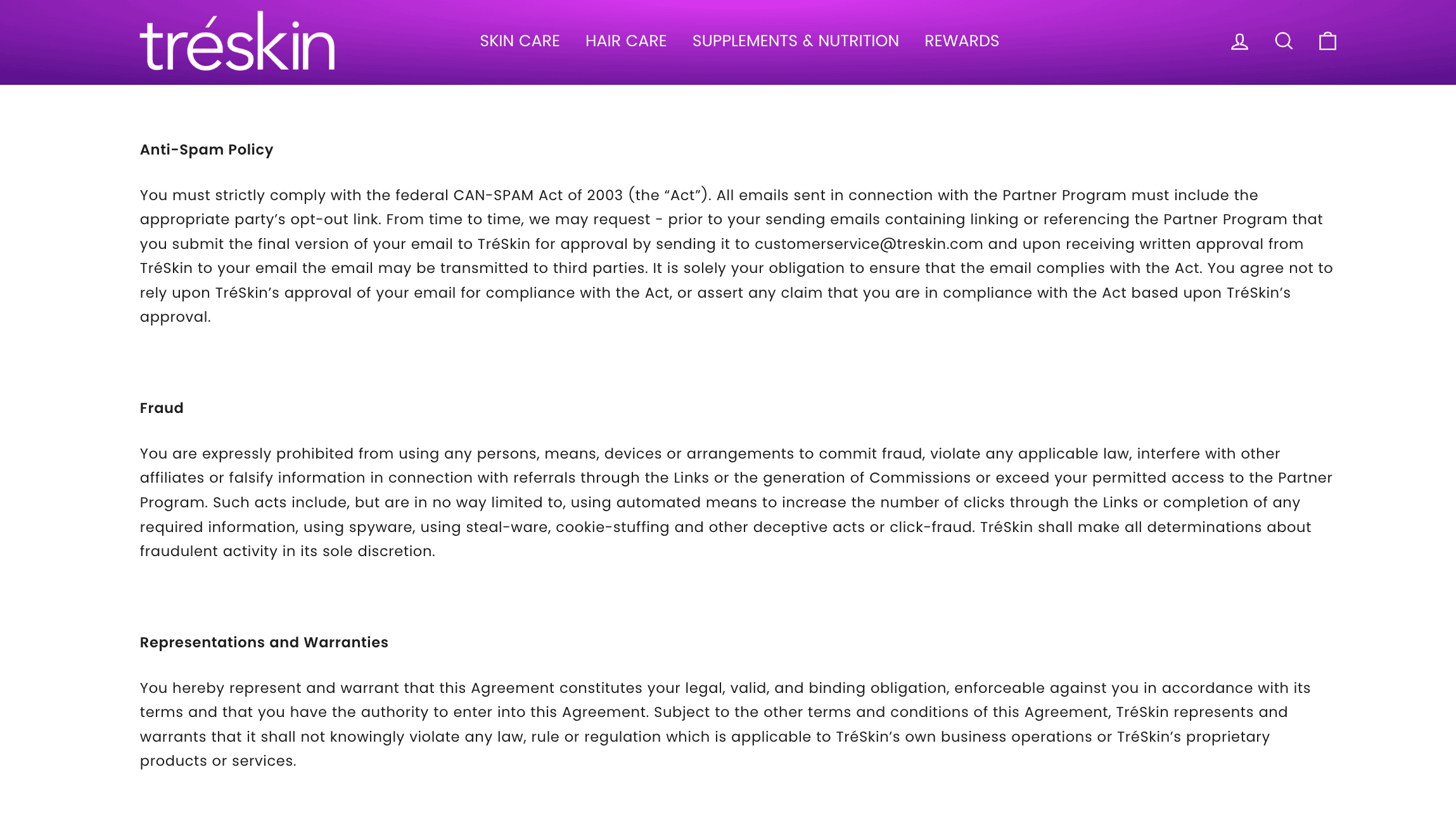
You need to regularly check to ensure affiliates follow these guidelines. If your partners have any questions, let them ask for clarification.
Regularly review and adjust your commission rates
Your affiliate marketing commission rate is not obligated to stay fixed. In fact, you should periodically review and adjust this rate to keep your ambassadors motivated and engaged. It’s also one of the great ways to help you attract new affiliates.
Checking on your commission is also essential to ensure you are ahead of some competitors. If a competitor program offers a more attractive commission rate, your affiliates might choose to work with them instead. Set up a regular plan to check out their programs.
Also, any change in your commission rate needn’t be permanent. Spice up your commission by choosing a specific period to offer a temporary bonus that may boost sales to the max.
In case you experience a slower month, this bonus will be an effective tool to drive more sales. It can be a flat rate commission (e.g., a $300 bonus for all affiliates making $1,500 worth of sales in August). Or a temporary boost (e.g., an extra 3% commission for November sales).
How To Choose The Right Affiliate Software To Set Affiliate Commission Rates?
Don’t be overwhelmed with various types of commission rates. You don’t need to set them manually. Using an affiliate marketing software will simplify the process.
Selecting the appropriate affiliate software is crucial for managing and optimizing your affiliate program. It can help you set competitive commission rates, track affiliate performance, and manage payouts seamlessly.
Here are the main factors to consider when choosing affiliate software that helps you set affiliate commission rates:
Key features to look for
- Commission flexibility: Can you set various types of commissions in the software? For example, percent-based, flat-rate, tiered, and performance bonuses? Ensure it helps you tailor the commission structure to your specific business needs.
- Accurate tracking and reporting: It tracks affiliate activities well. This includes clicks, conversions, and sales. Comprehensive reporting features help you monitor performance and make data-driven decisions when adjusting commission rates.
- User-friendly interface: Is it easy to navigate, with clear dashboards and intuitive controls?
- Customizable commission rules: Can you set custom commission rules? They would be based on product categories, affiliate performance, or promotional periods. These rules would enhance your program
- Support and resources: Make sure the software provider offers great customer support and resources. These include tutorials, webinars, and documentation. They help you get the most out of the platform.
Evaluating the affiliate marketing software based on business needs
- Assess your budget: How much can you pay for affiliate software? Are its pricing plans affordable? Consider the value offered by the software in terms of features and support.
- Identify your requirements: List your specific requirements, such as the number of affiliates, types of products or services, and preferred commission structures. This helps narrow down the options to those that best fit your business model.
- Provide a demo or free trial: Take advantage of demos and free trials to test the software’s features and usability. This hands-on experience helps you understand how the software works and whether it meets your needs.
- Evaluate scalability: Choose software that can scale with your business growth. As your affiliate program expands, the software should be able to handle increased traffic, more affiliates, and set advanced commission rates.
How to set up affiliate commission rates with UpPromote
To set affiliate commission rates, you can use UpPromote – the top-recommended affiliate solution on Shopify to streamline the process. Be free to establish any type of commission rates you want.
Access all commission models available in UpPromote and design one that captivates affiliates!
Step 1: Connect UpPromote with your store
Just simply connect our affiliate tracking software with your eCommerce store on Shopify. We’ll walk you through setting up an affiliate program as well as commission rates with built-in tooltips.
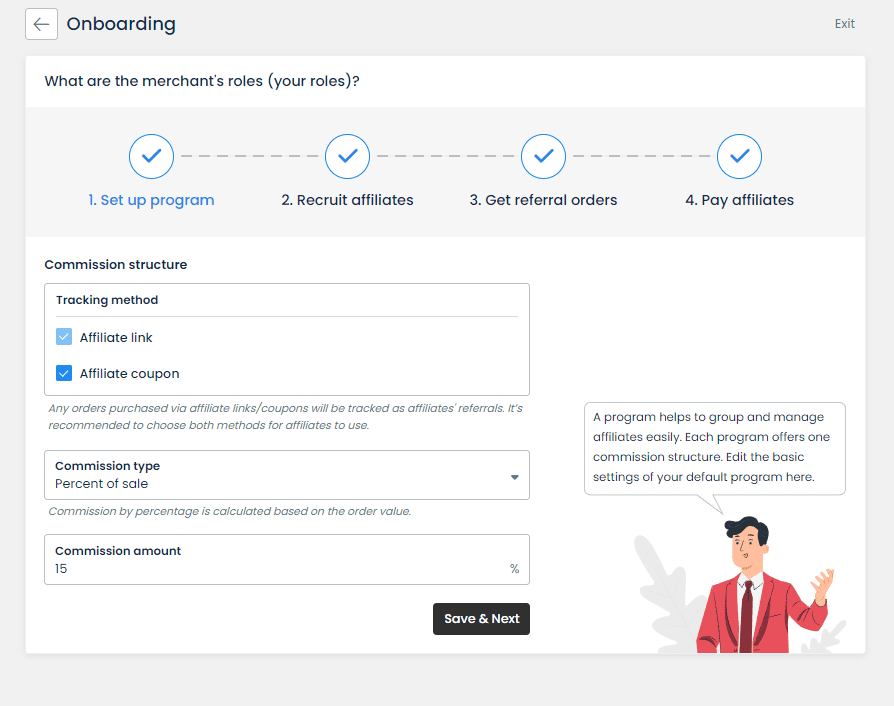
During the onboarding process, you can set up a simple default program for the payment process.
Step 2: Set simple commission rates for your program
After the onboarding process, you can adjust your affiliate program with its commission rate. Simply go to the Programs tab, and you’ll find the Program List.
To add a program, click Add program. To edit an existing program, click on its name.
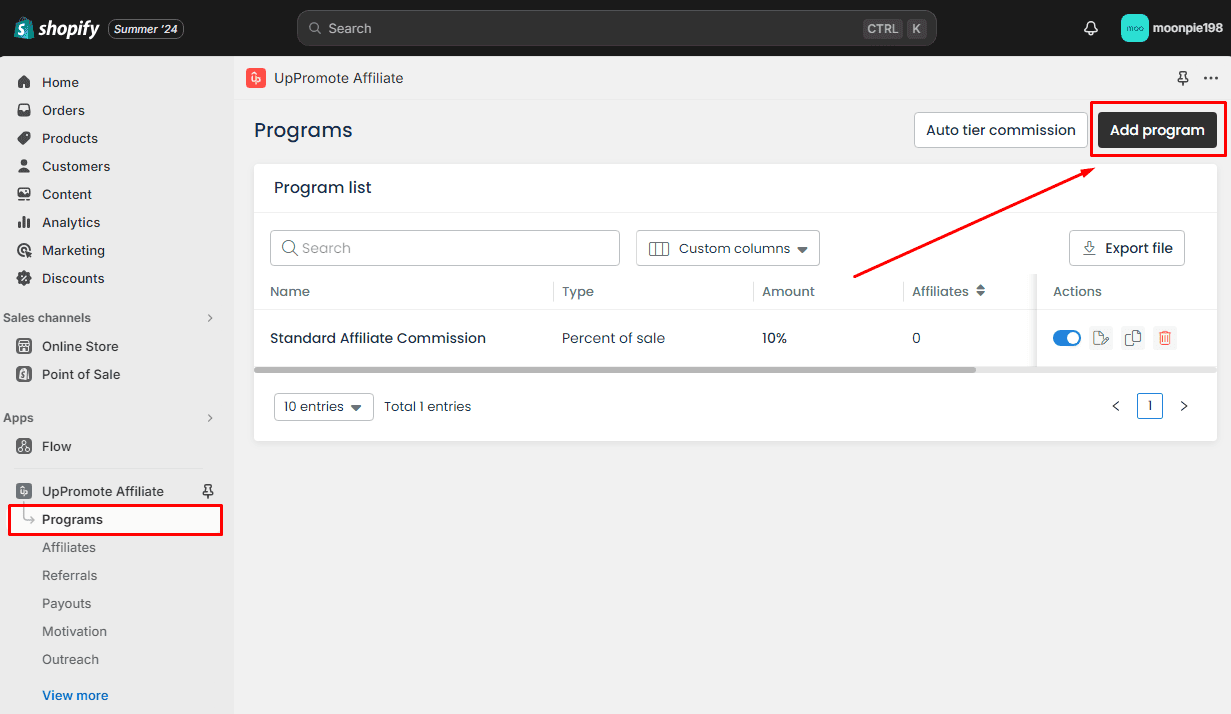
With Simple Commission Structure, you can choose among three types of commission:
- Percent of sale: a percentage of the affiliate’s total revenue, e.g., 10% of the total order amount.
- Flat rate per item: the number of product units sold. E.g.: $10 per item.
- Flat rate per order: a fixed amount on each referral order, e.g., $10 per order.
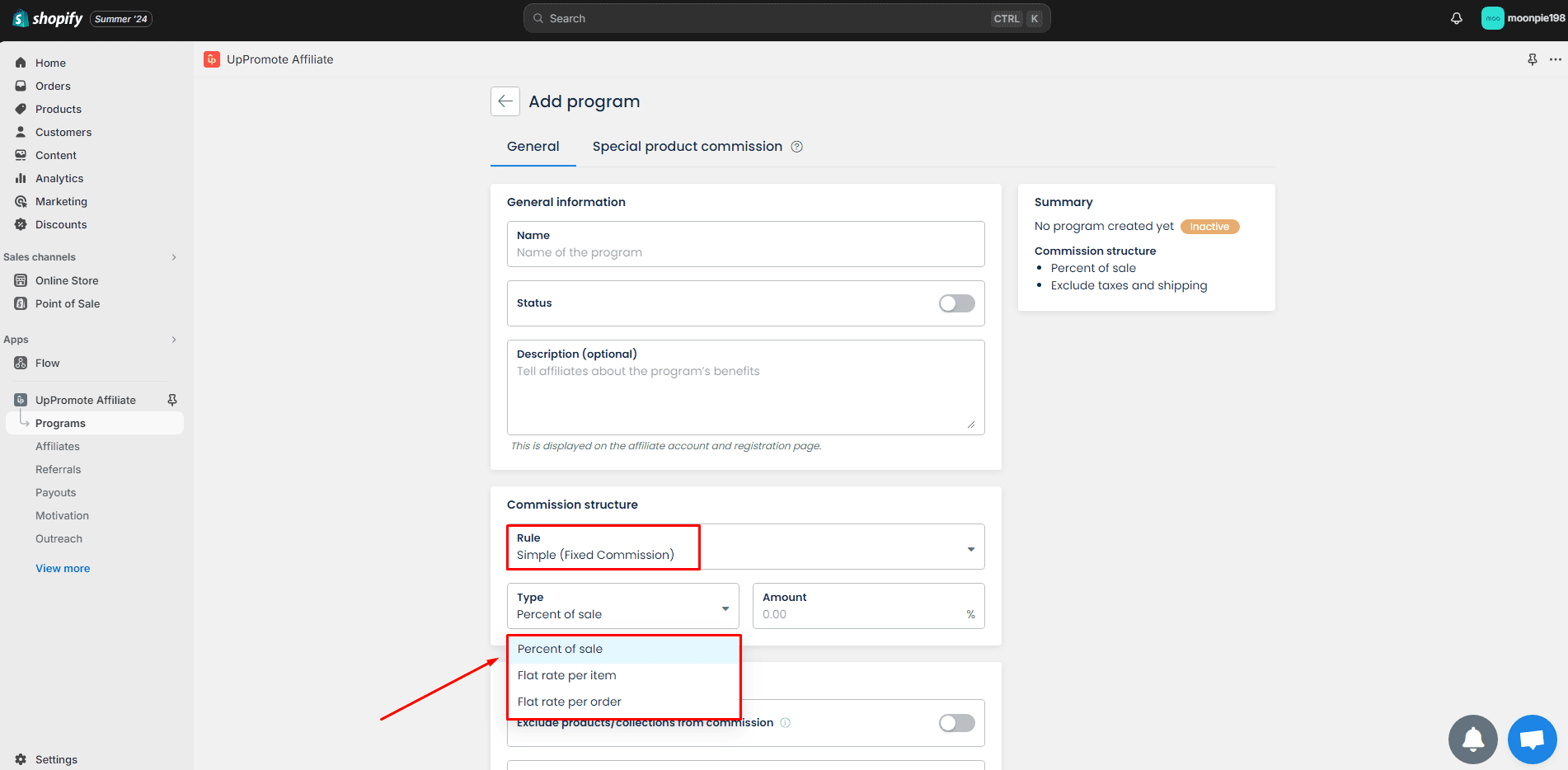
Note: Do you have any product or collection that you do not want to include in affiliate marketing strategies?
- In the Commission Calculation section, turn on the Exclude products/collections from commission toggle.
- Choose the products or collections you want to exclude from commission calculations, and click Save.
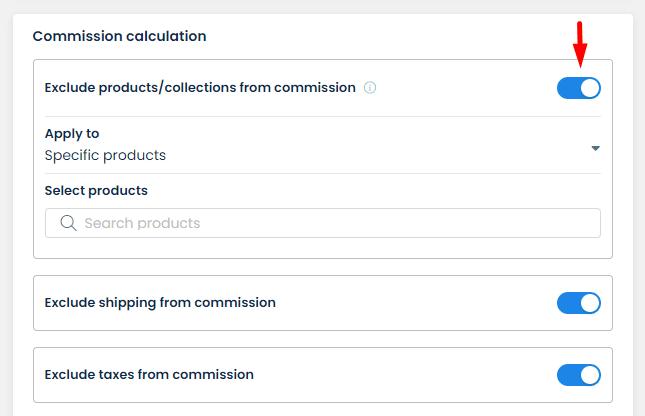
To make your affiliate commission rate more attractive, you can build a commission structure based on different levels of order value. This means that the more sales affiliates generate, the higher commission they receive.
For example, you can set the affiliate marketing percentage:
- Level 1: 10% for $0-$200
- Level 2: 15% for $200+
- Level 3: 20% for $500+
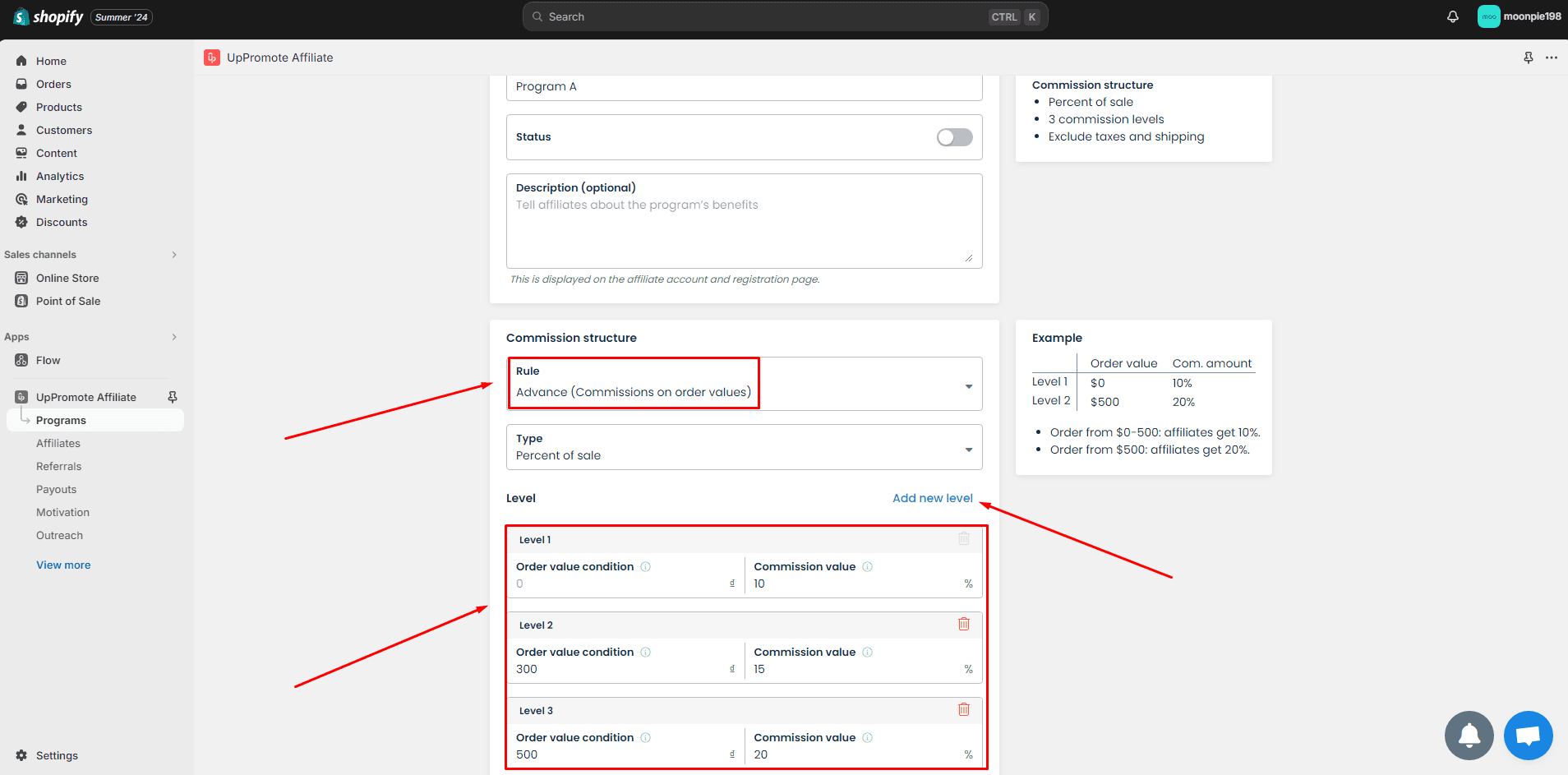
You can set dynamic commission rates for specific sales goals and add as many levels as you want. Set the minimum order value and the commission rate for each new level.
Render your dream rewards system with UpPromote’s smart commission settings.
Step 3: Customize advanced commission rates
The basic commission rate is not enough to attract more top talents while keeping the existing affiliates engaged and motivated. To make your affiliate program more appealing, UpPromote offers even more advanced commission rate settings.
Special product commission
Try out the Special Product Commission feature with our affiliate system software to incentivize affiliates to promote a particular product, like a seasonal item or limited edition line.
To enable this function, go to Programs > locate a program > click the program name > Special product commission.
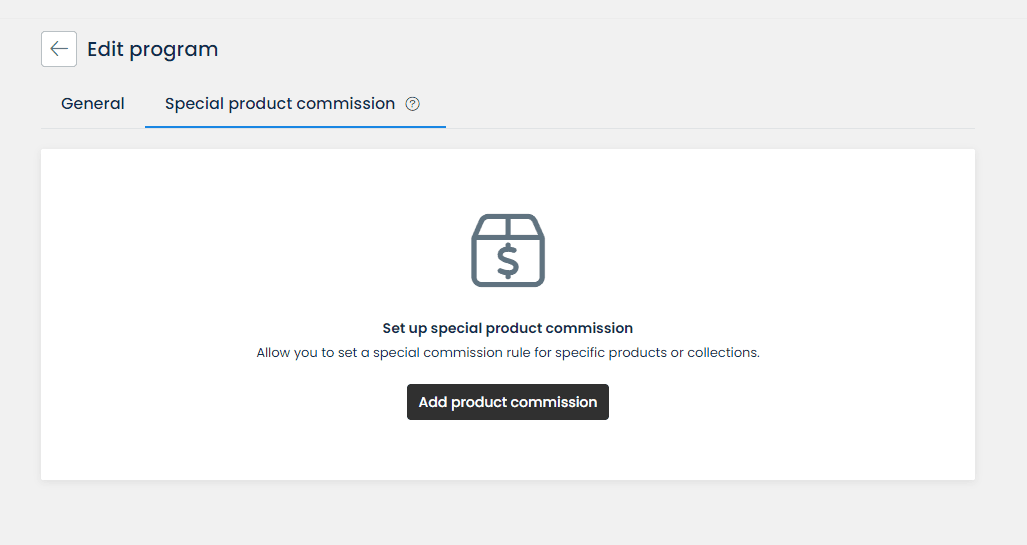
Then, choose whether to add a product separately or add a whole collection. Select your preferred item or collection and set the commission type. Enter an Amount/Rate, then click Add.
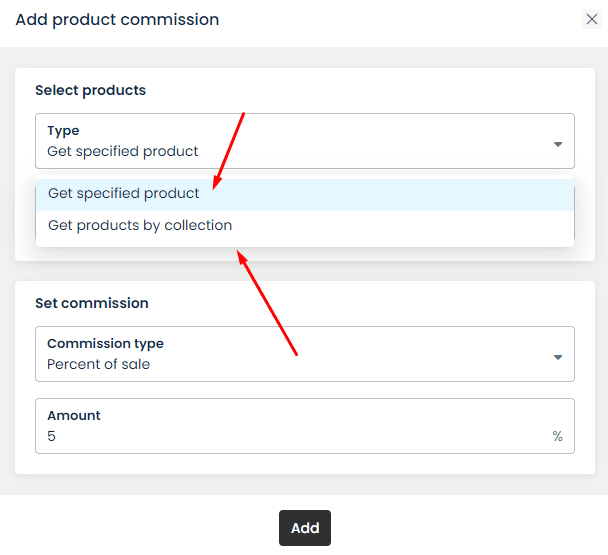
New customer commission
UpPromote lets you set up a different commission rate for affiliates when they refer a totally new customer who does not exist on your customer list with the New customer commission feature.
This function will encourage and motivate your affiliates to promote your store widely to refer new customers for a possibly higher commission rate/amount. It can also help incentivize underperformers to be more active in your affiliate campaign.
Within UpPromote’s dashboard, go to Programs > click on the program’s name > Advance > toggle on New customer commission.
Next, select a commission type (Flat per order, flat rate per item, or percentage of sale) and enter an amount or rate for it.
For example, you can offer affiliates a 25% commission on total sales when they refer brand-new customers to your store.

Lifetime commission
Enabling lifetime commission means you pay affiliates not only for the first sale they refer to but also for any future purchases the customer makes. It will create a strong incentive for affiliates to refer high-quality customers, ultimately boosting your revenue over time.
How to set up a lifetime Commission within UpPromote?
Go to Programs > Locate the program > Click on the program’s name > Advance > toggle on Lifetime Commission.
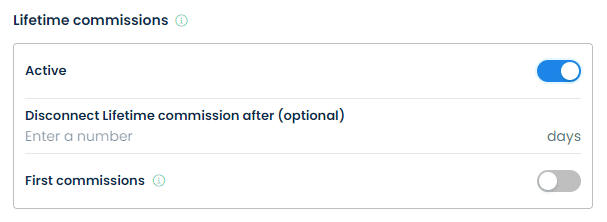
Auto-tiered commission
A tiered commission structure motivates affiliates using commission rate tiers. Unlike a flat commission plan, tiered commissions encourage affiliates to reach higher sales targets. As their sales increase, they move up to higher commission levels, earning more for their efforts.
With UpPromote, you can easily build your own auto-tier commission rule with five main conditions. Our system will level up your affiliates automatically as long as they meet your setting. The conditions might be based on:
- Total sales of all referrals: the total value of sales referred by the affiliate. Both approved and paid commissions count.
- Total earned commissions: the total value of approved and paid commissions the affiliate receives.
- Total referral quantity: the number of sales referred by the affiliate. Both approved and paid commissions are counted.
- Total sales of downline affiliates (MLM related): the total value of approved sales made by the affiliate’s downlines.
- Total sales of personal volume (MLM related): the total value of sales referred by the affiliate, excluding network commissions from downlines (if the Multi-level marketing feature is enabled).
To set the condition values, go to Programs > Auto-tier commission.
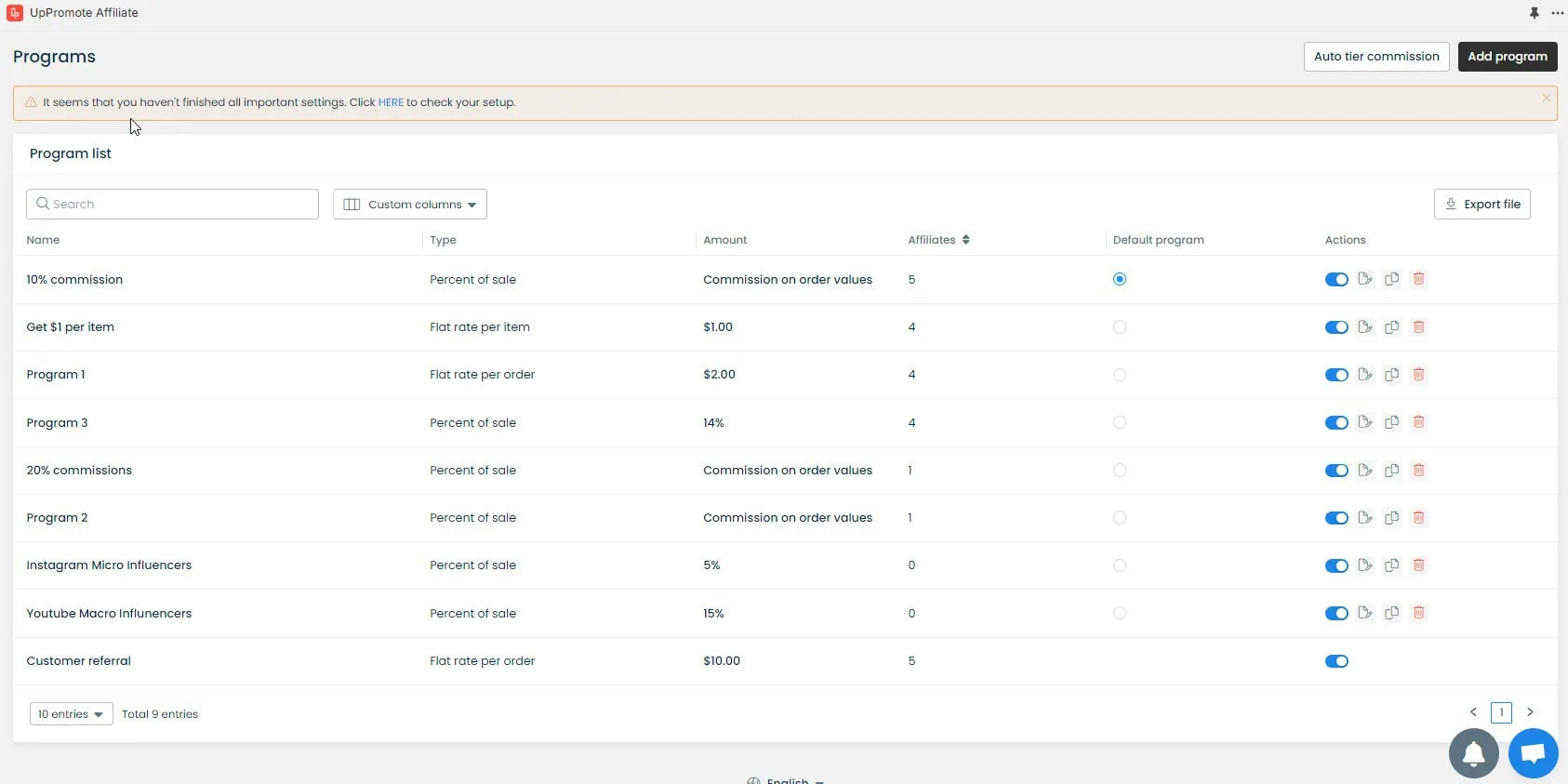
Then, switch on “Active” to enable the Auto-tier commission feature. Choose a level condition, a program, and its condition value accordingly.
For example:
You choose the level condition is Total sales of all referrals.
There are 3 programs available in the account. You can set the conditions as below:
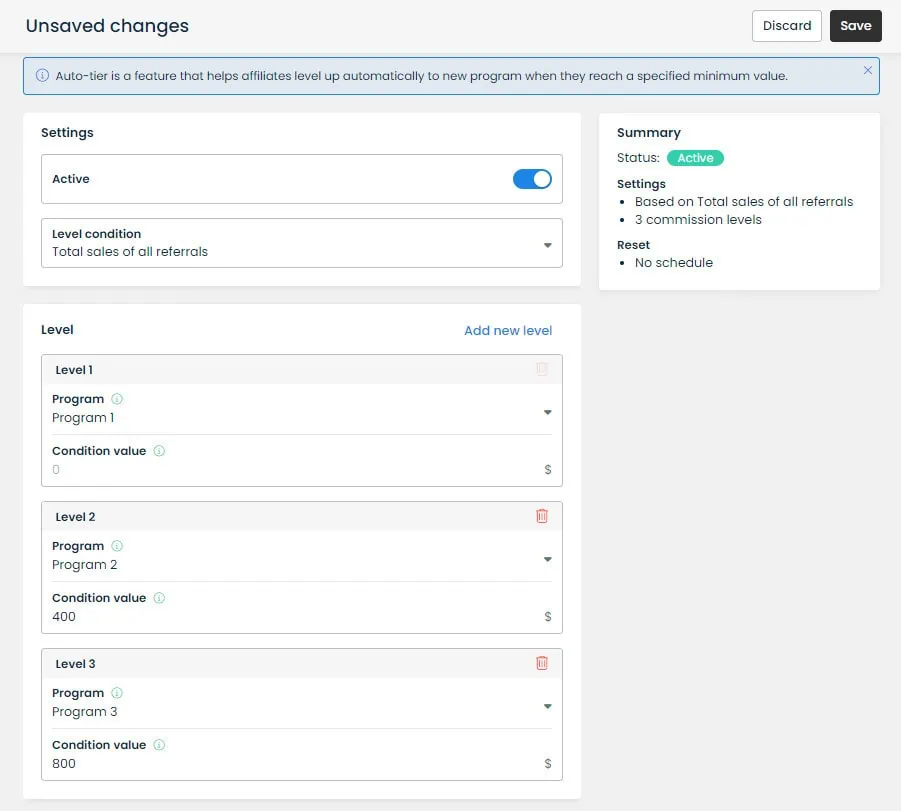
In this setting:
- Affiliates who brought less than $400 in total referral sales (only sales of approved commission count) will stay on program 1.
- Those who reach $400 in total sales will be moved automatically to program 2.
- Similarly, they will be moved to program 3 as long as they reach $800 sales in total.
Coupon code commissioning
Giving discounts to customers and offering affiliate link commission rate commissions to publishers at the same time can significantly affect your profit. In such cases, you may want to reduce the commission rate to ensure profitability.
Try out the Coupon code commissioning feature in UpPromote. It helps you adjust the commission rules for referral orders that use a coupon code. You can set a lower or higher commission rate for referrals using coupons than those promoted by links.
To enable this function for a program, go to Programs > Locate the program you want > Click on the program’s name > Advance > switch on Coupon code commissioning.
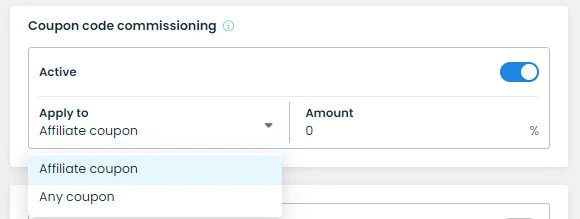
It can be applied to Affiliate coupons (coupons assigned to your affiliates) or Any coupon (including affiliates’ coupons and your shop’s discount codes that are not assigned to any affiliates).
In the Amount field, you can enter a commission rate that you want to apply for orders using coupons. The commission type will be based on what you set in the Commission structure in the Program settings.
What To Consider For Setting An Affiliate Marketing Commission Rate?
Now that you get your guide affiliate commission rate. What else is there to take into account?
Structuring the right commission rate is not a straightforward, simple task in creating an affiliate program. It depends on various factors, including the products sold, the current market competition level, and your program’s particulars.
Sadly, no universal solution can be applied to this case. However, generally, a good commission rate is competitive and reasonable. Yet, it still makes room for your business to have profits.
For example, a 10-20% commission is common for most sectors, but some brands may give larger commission rates than typical affiliate marketing commission for specific items or high-performing affiliates. All in all, the commission rate that benefits both the affiliate and your business is the ideal one.
FAQs
Q: Who pays the commission in affiliate marketing?
In a standard affiliate network or program, the merchant pays a commission to their affiliates when a customer successfully purchases via the affiliate link.
Q: What is the difference between affiliate and referral?
Affiliates get paid a commission for sales, subscriptions, and other consumers’ actions using their affiliate links. Referral programs usually distribute rewards and incentives through discounts, cashback, a free service subscription, or store credit.
Q: What is a good commission rate for affiliates?
In general, the average affiliate marketing commission rate lies between 5 and 30%. Most businesses will start on the lower end and increase this rate as the brand grows. This rate should be attractive to your affiliates and affordable within your payment ability.
Conclusion
Follow our detailed guide, and you will be able to structure your affiliate marketing commission rates and conditions that best benefit your business. A good commission rate is attractive to potential affiliates. It also fits your long-term budget.
To truly motivate your affiliates and build trust, remember to pay out their commissions in a timely manner. You can try some convenient affiliate software programs with automatic payouts to ensure your partners are paid on time.


